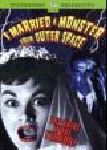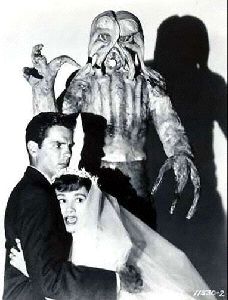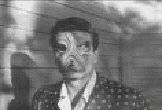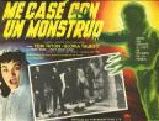Alien Inamorato
by Steven Utley
Here’s a piece related to “Confessions of a Cinemasochist,” and probably there will be more in the near future — and in case you’re wondering, this recent spate of submissions derives from my working on All Stories Mostly True, a collection of essays, japes, etc., including all of the prose pieces from Bewildering Stories.
Steven
 I Married a Monster From Outer Space (Paramount, 1958) encapsulates its pure 1930s-scientifiction-pulp absurdity of a plot in a title that has always been a contender for top honors in Worst Movie Title competitions. (The perennial winner, however, is I Eat Your Skin.) And exactly how absurd (you ask) is 1930s-scientifiction-pulp? Well, imagine that you are marooned on the fourth planet out from (say) Tau Ceti, desperate to obey the call to reproduce your species, but hampered by the lack of a suitable partner: how willing — be honest now, and imagine also that you are neither a disgusting pervert nor already desperate to obey the call to reproduce your species but hampered by the lack of a suitable partner — how eager would you be to make do, as in make whoopee, with a member of the dominant life-form there, which, for all anybody knows, might be a sentient cantaloupe, or a kind of armored maggot as big as a refrigerator?
I Married a Monster From Outer Space (Paramount, 1958) encapsulates its pure 1930s-scientifiction-pulp absurdity of a plot in a title that has always been a contender for top honors in Worst Movie Title competitions. (The perennial winner, however, is I Eat Your Skin.) And exactly how absurd (you ask) is 1930s-scientifiction-pulp? Well, imagine that you are marooned on the fourth planet out from (say) Tau Ceti, desperate to obey the call to reproduce your species, but hampered by the lack of a suitable partner: how willing — be honest now, and imagine also that you are neither a disgusting pervert nor already desperate to obey the call to reproduce your species but hampered by the lack of a suitable partner — how eager would you be to make do, as in make whoopee, with a member of the dominant life-form there, which, for all anybody knows, might be a sentient cantaloupe, or a kind of armored maggot as big as a refrigerator?
So, why (you ask further), with its unappetizing title and its impossible monster + Earthwoman = baby premise, is I Married a Monster From Outer Space just my all-time favorite grade-B science-fiction movie?
Let me begin by explaining that I was a military brat, born and bred. In 1958, my father, a noncommissioned officer in the Air Force, was sent to Okinawa; because my mother, my siblings, and I had to wait Stateside for a year before we could go overseas, we moved from Memphis to a small town in western Kentucky. I probably expected to enjoy that year in a region that was home to my beloved grandparents and other relatives, including cousins my age — instant playmates. It turned out to be hell. Beset by peers who were not cousins of mine and therefore under no obligation to get along with me — who, by and large, did not cotton to outsiders and in any case didn’t know what to make of somebody who liked to read about prehistoric animals, the Civil War, and Custer’s Last Stand — I sought surcease in such arts as were available to me. My weekly allowance covered the cost of a comic book or two and admission to the town’s decaying movie house. Thus, I was able to sharpen my imagination on Classics Illustrated, The Flash, Blackhawk, or (best of all) the dinosaur-infested Turok, Son of Stone, preparatory to soaking up a Saturday matinee.
Science-fiction and fantasy were my favorite fare, and so grateful was I for First Man Into Space, Queen of Outer Space, The Blob, The 7th Voyage of Sinbad, The Revenge of Frankenstein, The Return of Dracula, and It! The Terror From Beyond Space that critical judgments were almost beside the point. But I Married a Monster From Outer Space did not simply hold my attention for an afternoon, it resonated for me, and resonates still. IMaMFOS (as we’ll call it) is inextricably bound up in my memories and my emotions with the perfectly swell 1940 version of The Mark of Zorro — starring Tyrone Power, Linda Darnell, Basil Rathbone, Gale Sondergaard, Eugene Pallette, and J. Edward Bromberg — which 20th Century-Fox re-released in the late 1950s to capitalize on the success of Walt Disney’s new TV version. If my memory does not play me false and I did in fact see the two films on the same bill one day in 1958 or ‘59, I must count that among the happiest occasions of my childhood and all the more so for being embedded in a twelvemonth’s worth of unhappy occasions. IMaMFOS and The Mask of Zorro are about formidable outsiders who, disguised as an insurance salesman and a Spanish dandy, respectively, impose their wills on insular communities. Little wonder that I should have warmed to them!
 Quite apart from the emotional boost IMaMFOS gave my needful young self, the film actually works in its own right. The monster of the title is one of a number of approximately male survivors of a cosmic catastrophe that destroyed their home world and wiped out their approximately female mates. Desperate to perpetuate their kind, the aliens search the cosmos for other life, reach Earth, dispatch a landing party. Having concealed their spacecraft in a thicket on the outskirts of a small suburban community, the scouts capture various eligible young men, appropriate their forms and memories, and start marrying their sweethearts. As events unfold, it is darkly hinted that these connubial methane-breathers are tinkering with their own genetic material (this in 1958, long before the word “bioengineering” gained currency) so that their unsuspecting human brides can incubate nonhuman babies (this, too, long before the concept of foster-wombs entered public consciousness).
Quite apart from the emotional boost IMaMFOS gave my needful young self, the film actually works in its own right. The monster of the title is one of a number of approximately male survivors of a cosmic catastrophe that destroyed their home world and wiped out their approximately female mates. Desperate to perpetuate their kind, the aliens search the cosmos for other life, reach Earth, dispatch a landing party. Having concealed their spacecraft in a thicket on the outskirts of a small suburban community, the scouts capture various eligible young men, appropriate their forms and memories, and start marrying their sweethearts. As events unfold, it is darkly hinted that these connubial methane-breathers are tinkering with their own genetic material (this in 1958, long before the word “bioengineering” gained currency) so that their unsuspecting human brides can incubate nonhuman babies (this, too, long before the concept of foster-wombs entered public consciousness).
The aliens aren’t the only ones who are anxious to have children. Marge Farrell (Gloria Talbot), wife to the pseudo-Bill (Tom Tryon, later a best-selling author), wants children, too, and can’t understand why she isn’t having any. Moreover, Bill seems so remote, so cold — so changed from the man she fell in love with.
 The screenplay, by Louis Vittes, is smarter than its hoary premise (the alien un-men have their individual quirks; one even manifests a slightly off-color sense of humor) and gets tremendous help from director Gene Fowler, Jr. Fowler had worked with Fritz Lang, and it shows: the film is all dark, brooding, paranoid menace — except for moments of visceral creepiness, as when a lightning flash startles the pseudo-Bill and reveals the alien horror behind the human mask. Or: Marge follows her husband into the thicket at night, sees the alien emerge from him, then sees a beetle walk across the empty humanoid shell’s unblinking eyeball.
The screenplay, by Louis Vittes, is smarter than its hoary premise (the alien un-men have their individual quirks; one even manifests a slightly off-color sense of humor) and gets tremendous help from director Gene Fowler, Jr. Fowler had worked with Fritz Lang, and it shows: the film is all dark, brooding, paranoid menace — except for moments of visceral creepiness, as when a lightning flash startles the pseudo-Bill and reveals the alien horror behind the human mask. Or: Marge follows her husband into the thicket at night, sees the alien emerge from him, then sees a beetle walk across the empty humanoid shell’s unblinking eyeball.
When Marge convinces the real men left in town to attack the hidden spacecraft, they are quickly put to rout by beings who brush trees out of the way, shrug off shotgun blasts, and shoot back with disintegration rays. We are supposed to be relieved when they finally are killed and dissolved to ghastly porridge. After all, the aliens are ugly (really the most alien-looking aliens to be seen in any film of the period), they’ve shown themselves to be pretty ruthless, and they’ve been messing around with our womenfolk. Yet, one cannot help feeling sympathy for their plight.
 And we are also supposed to be relieved when Marge is reunited with the real Bill — or, rather, united with him, since he was captured by the invaders before the nuptials. Throughout, Marge has seemed to be a traditional young woman with traditional notions about love, marriage, and, presumably, sex. Given those values, which the real Bill surely shares to some extent, and given that, whenever we may be watching IMaMFOS, all of what we watch has taken place, is taking place, will forever take place in 1958, what I find myself wondering, here in the 21st Century, is how Bill is going react to the news that his sweetheart has already Given Herself, and to a space monster, too. What is Marge going to say to him after the end-credits? “I swear I thought it was you”?
And we are also supposed to be relieved when Marge is reunited with the real Bill — or, rather, united with him, since he was captured by the invaders before the nuptials. Throughout, Marge has seemed to be a traditional young woman with traditional notions about love, marriage, and, presumably, sex. Given those values, which the real Bill surely shares to some extent, and given that, whenever we may be watching IMaMFOS, all of what we watch has taken place, is taking place, will forever take place in 1958, what I find myself wondering, here in the 21st Century, is how Bill is going react to the news that his sweetheart has already Given Herself, and to a space monster, too. What is Marge going to say to him after the end-credits? “I swear I thought it was you”?
Copyright © 2005 by Steven Utley
